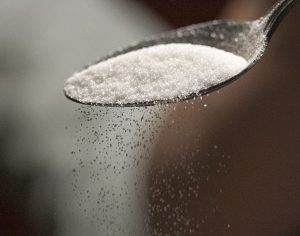Will the sugar in your drinks lead to an overweight baby?

Women consuming sugar filled drinks during pregnancy increased the likelihood of having overweight children. Of note, there was no difference if the sugar came from soda or fruit juices.
The Research:
Pediatrics. 2017 Jul 8. pii: e20170031. doi: 10.1542/peds.2017-0031. [Epub ahead of print]
Beverage Intake During Pregnancy and Childhood Adiposity.
Gillman MW1, Rifas-Shiman SL2, Fernandez-Barres S3,4, Kleinman K5, Taveras EM6, Oken E1.
Abstract
OBJECTIVES:
To examine associations of sugar sweetened beverages (SSBs) and other beverage intake during pregnancy with adiposity in midchildhood (median age of 7.7 years).
METHODS:
We studied 1078 mother-child pairs in Project Viva, a prospective prebirth cohort study. Exposures were sugary and nonsugary beverage intake assessed in the first and second trimesters of pregnancy by using a food frequency questionnaire. Main outcome measures were offspring overall adiposity (BMI z score, fat mass index [FMI, kg/m2] from dual-energy radiograph absorptiometry, and sum of subscapular [SS] and triceps [TR] skinfold thicknesses) and central adiposity (SS:TR ratio and waist circumference).
RESULTS:
In the second trimester, mean (SD) SSB intake was 0.6 (0.9) servings per day. Thirty-two percent of mothers were multiracial or people of color, 68% were college graduates, and 10% smoked during pregnancy. In midchildhood, mean (SD) BMI z score was 0.38 (1.00), and the FMI was 4.4 (1.9) kg/m2. In multivariable models adjusted for multiple maternal and child covariates, each additional serving per day of SSB was associated with higher BMI z scores (0.07 U; 95% confidence interval [CI]: -0.01 to 0.15), FMI (0.15 kg/m2; 95% CI: -0.01 to 0.30), SS + TR (0.85 mm; 95% CI: 0.06 to 1.64), and waist circumference (0.65 cm; 95% CI: 0.01 to 1.28). Stratified models suggested that the associations were due primarily to maternal, not child, SSB intake and to sugary soda rather than fruit drinks or juice. We did not find differences between boys and girls, nor did we observe the effects of sugar-free soda or of first-trimester beverage intake.
CONCLUSIONS:
Higher SSB intake during the second trimester of pregnancy was associated with greater adiposity in midchildhood.











